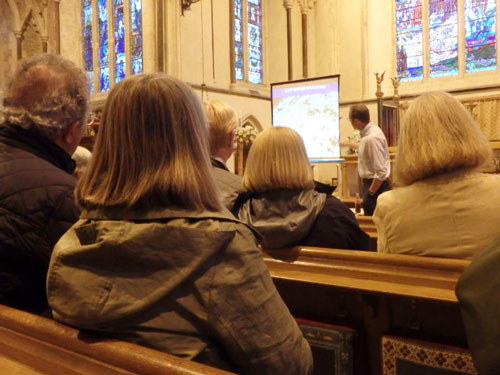While the Bexhill-Hasting link road remains a controversial environmental story, East Sussex County Archaeologist Casper Johnson believes it is radically changing our understanding of the prehistory of the county. At a talk hosted by the Winchelsea Archaeological Society (WAS) at Winchelsea Church, he explained how the large area made available for investigation had revealed over 100 scatters of flint-workings, a huge increase in the amount of worked flint found in East Sussex.
Although much further analysis is needed, it appears from these sites that human occupation of the river valleys crossed by the road dates back to at least 8000BC. And it is likely that the county was much more densely populated than was previously thought. In part, this was because the Weald was an open landscape at that time. Another surprise was that, by about 4500BC, when the Weald was covered in oak, beech and lime forest, the Mesolithic hunter-gathers seemed to have settled territories within which they moved between regularly occupied sites.
A little glimpse into everyday life thousands of years ago was provided by the pattern of the flint scatters. At the centre of each is a small butterfly-shaped open area. This is where the flint worker sat. And several sites tended to cluster around larger open areas, which appear to have huts or trees. The quality of the flintwork was as fine as any found elsewhere in Europe. As the climate and environment changed, so did the tools made by the flint workers. In partcular, the large tools such as spearheads, that were used to hunt large game in the open terrain that followed the end of the Ice Age, were replaced by delicate arrowheads used to hunt smaller and faster animals in the Wealden Forest.
Another discovery was a barrow, only the second found in East Sussex, the first having been found at Playden. Others have since been uncovered at other sites and the county now has eight!
Casper Johnson also commented on the careful planning and sophisticated techniques employed by the archaeological contractors, Oxford Archaeology, which had set new standards for future work. The results are expected to start being published in about 2017. One of the outcomes will be a much better idea of where to look for prehistoric remains, as a result of which, we can expect our knowledge of local prehistory to advance rapidly in the future.
There is a temporary exhibition about the archaeology of the link road, including some finds, at the Bexhill museum, which runs to December.
Pfotograph by Richard Comotto of the Winchelsea Archaeological Society



